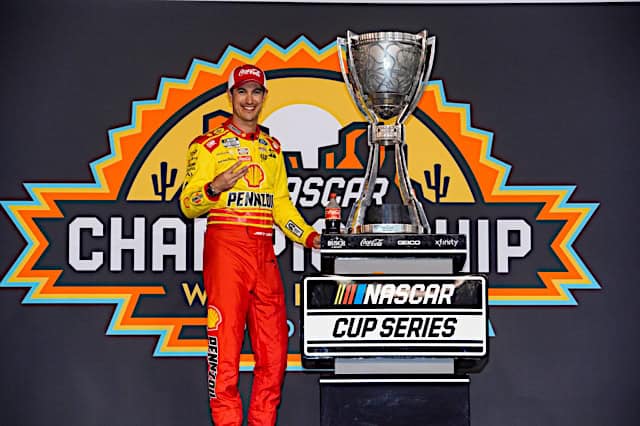With the playoffs and the championship format under constant scrutiny from fans and the media throughout the entire 2025 season, the writing is on the wall: the upcoming championship weekend at Phoenix Raceway will mark the end of an era, in one way or another.
The championship format that NASCAR will use for 2026 has yet to be determined, but Jordan Bianchi of The Athletic revealed earlier this week on the Door Bumper Clear podcast that there are three potential championship formats in play: a full-season points system (used prior to 2004), a 10-race chase (used from 2004 to 2013) or a modified 3-3-4 elimination format with two three-race rounds followed by a four-race final round (the format NASCAR currently uses is 3-3-3-1).
Which one will NASCAR choose? Better yet, what is the ideal format that NASCAR should choose? – Stephen Stumpf
Couch Potato Tuesday: Martinsville Is a Playoff-Obsessed Dud
Full-Season Points
It almost seems too good to be true: after decades of resistance, the sanctioning body is finally open to changing up the championship format. And, most notably, a return to a full-season title is on the table.
Simply put, the full-season formula is what every race fan should want. It’s not sexy like the over-dramatic playoff system, and it’s not a chance at a new beginning like
the old Chase. But you know what it is? Legitimate. It’s legitimate.
Let me explain. A lot of race fans, of both NASCAR and other forms of racing, will look at a playoff champion, or even a Chase champ, and make a strong argument about why he shouldn’t have won. Sometimes those arguments are stronger than others, but they’re always there. I’m a firm believer that you can’t just look at the full-season points for any given year since 2004 and definitively say that whoever had the most points under that format would for sure have won. That’s patently false. But the reason it’s false is the reason that the Chase and playoffs are failures.
It’s false because under a full-season format, there’s no room for error. Teams can’t game the system, because there are no guaranteed spots, no time to back down. They have to race for every point, every week. Under the Chase and the current system, teams figured out that once they had done enough to get into the postseason, they could use certain races, often a lot of them, to try things for the
championship run later in the year. If that meant sacrificing a race here and there, so be it. We all saw it last week at Martinsville Speedway. Instead of focusing on the race at hand, the two drivers already locked into the finale appeared to be trying something to gain an advantage in the title race.
If they were trying something, it didn’t work, as both drivers suffered mechanical
failures and failed to finish. While that could have been organic, that’s unlikely, as they have not had similar issues all year long. That’s not fair to their fans who bought race tickets in hopes of seeing their favorites contend. Maybe they don’t mind if it helps their favorite win a championship, but fans pay for race tickets, not an extended test session. And for some teams, this happens in a lot more than one
race.
Even back in the Chase days, it was a thing. Jimmie Johnson always seemed to start off hot, have a midsummer slump, and then pour it on for the final 10 races. It has continued ever since Johnson and Co. proved it works. That subpar month a team had in May was never bad luck; it was by design. It’s not fair to fans, and it’s the complete opposite of what this sport is about.
Teams will still try things to better themselves under a full-season format. That won’t stop, but they can’t sustain it over weeks. That means fans paying for race tickets or tuning in on TV will see their favorite run as hard as they can for every point, every week. It also makes it exceptionally hard for a driver who isn’t consistently competing for wins every week to compete for a title, which is how it should work. While the Next Gen car has had an effect on the racing, the number of top fives and top 10s a driver needs to compete for a title has dropped.
Matt Kenseth had 25 top 10s in 36 races in 2003. Three of the four Cup finalists this year have fewer than 20. But wait, you say. Kenseth also only had one win in 2003, and all four Cup contenders this year have at least three. True. But two of the four in the Truck Series and one in the Xfinity Series are going in with zero wins, and it’s entirely plausible that one of those drivers could take the honors without a win against a driver who has 10 or more.
That is absolutely absurd.
If you want a champion who had to dig deep every single week and fight for every single point to win the title, then the only answer is a full-season system that rewards wins with a larger point payout. Full season titles are good enough for other reputable racing series, including Formula 1, because they work to produce a worthy champion. NASCAR fans deserve that, too. – Amy Henderson
10-Race Chase
The system to crown a champion in NASCAR is a contentious topic, with many fans wanting a return to the full-season points format. However, there is still a portion of the fanbase and some drivers who like the playoff system, and those opinions should matter, too. It is important that NASCAR reaches a compromise that pleases both groups of fans.
Which is why a 10-race Chase is the best possible system for NASCAR to use going forward, as it is a compromise between full-season points and the elimination playoffs. The 10-race Chase will reward consistency while still ensuring that there is a battle for the championship every season that will keep fans engaged.
Both the full-season points format and the playoff system have flaws, so let’s start by pointing out the downside of full-season points. The full-season points format has the probability of a driver running away with the championship and causing fans who are not diehards to tune out of races. Keep in mind, championship battles under the full-season points format, like 1992, are remembered so fondly because those battles were rare. The most likely outcome for a full-season points format is for a driver to dominate and take it all, and while that outcome may be best in an ideal world where viewers want to see a deserving and dominant performance from the champion, it is likely to not translate well to the business side of the sport where many viewers will almost certainly tune out if the championship battle got to such a point of dominance.
Now, let’s focus on the current playoff system that has 16 drivers go through multiple rounds of elimination until four survive and duke it out for a winner-take-all final race for the championship. This system has a laundry list of flaws, chief among those is that this system creates champions who many fans feel are illegitimate champions. This is because all a driver has to do under the current format is win a regular season race and lock themself in the playoffs, then luck their way into the Championship 4 through the rounds of elimination and bring their best car to the track hosting the championship and finish ahead of the other three drivers in the Championship 4.
Arguably, the second biggest flaw with the playoff format is the fact that the system is unnecessarily complicated to the point where it could deter prospective new fans from becoming regular viewers. Many fans want to be able to watch NASCAR and be entertained, and it is hard to be entertained when the system to crown a champion makes no sense. Many fans have already tuned out because of the playoff system, and many more will continue to do so.
Despite the flaws with both systems, you will still find fans who support one or the other, and that is perfectly fine. However, NASCAR has to do something about the current playoff system, as viewership is declining, and both active and retired drivers voice their displeasure with the system.
In order to please both the full-season points supporters and the playoff format supporters, NASCAR should bring back the 10-race Chase as a compromise between both systems. If NASCAR brings back the original 10-race Chase format, the top 10 drivers in points are in, and there is no win and you’re in. The driver at the top of the standings starts with the most points, so there is a benefit for performing during the regular season, and the 10 races in the Chase are run without eliminations; the driver who leads the standings at the end of the Chase is the champion, which ensures the championship battle is competitive into the late season.
The 10-race Chase format would be the best of the full-season points format and the playoff format. It would be a compromise that can bring legitimacy back to the championship and still keep fans excited and engaged. – Logan Kendall
NASCAR Phoenix Entry Lists
Eliminations with a Four-Race Final Round
By now, you’ve seen some of the more glamorous options on the table if NASCAR is going to change its playoff format for 2026 and beyond. But there’s one last avenue that the series can take, and it involves tinkering ever so slightly with the present format.
If NASCAR wants to continue with its emphasis on winning and clutch moments, the 3-3-4 playoff format provides the best of both worlds. You want a bigger sample size to make consistency matter while creating a longer runway? You got it. You want a moment where some potential rough races get course corrected with 11th-hour wins? You got it.
On the other hand, it’s not a one size fits all approach. The way the schedule lays out is crucial, especially for someone like Shane van Gisbergen, who dominates road courses but isn’t where he wants to be on ovals. Conversely, William Byron’s Martinsville win would’ve been more of footnote given the context of his finishes at Las Vegas Motor Speedway and Talladega Superspeedway. Kyle Larson and Christopher Bell would be sitting pretty given their contributions in the Round of 8 and would be the favorites heading into a Phoenix race where stage points all of a sudden matter again. Did you remember stage points are useless to the championship 4 in this format at the finale? This 3-3-4 format would make them count.
The theme that comes to mind in this 3-3-4 format is cautioned balance. It’s certainly not a 36-race format, nor is it a 10-race Chase counterpart that provides a larger sample size in a postseason. But what it does do is give NASCAR the tools to carve space in an era where they want viral moments, all while increasing the sample size to more than just one race. Whether you want those viral moments is up to your interpretation, but the sanctioning body clearly values winning and moments that matter.
Turning toward 2026, you need to see this in practice. Next year’s schedule presents the following races if this format were to be adopted: Phoenix, Talladega, Martinsville and Homestead-Miami Speedway. A diverse allotment of tracks with a 1-mile oval, a superspeedway, a short track and a 1.5-mile oval, that’s ample opportunity across several situations to prove your worth as a deserving champion.
I understand the trepidation in having Talladega involved in this final four, but the fact of the matter is that you have to deal with it no matter what round and which format. Furthermore, we’ve seen the adaptability from Ben Kennedy in formatting the series’ schedules, so if there’s an obvious change that needs to be made in the flow of this playoff structure, there’s a known quantity that can and has been listening.
The 3-3-4 format signals a willingness to adjust while not scrapping your identity, simply giving your best drivers more chances to show their best. It’s more than time for the one-race finale to go, and four races at a point in the season when you should already be at your best is enough to illustrate that you’ve earned a NASCAR championship. – Thomas Dunn
NASCAR Content Director at Frontstretch
Stephen Stumpf is the NASCAR Content Director for Frontstretch and is a three-year veteran of the site. His weekly column is “Stat Sheet,” and he formerly wrote “4 Burning Questions” for three years. He also writes commentaries, contributes to podcasts, edits articles and is frequently at the track for on-site coverage.
Find Stephen on Twitter @stephen_stumpf
Amy is an 20-year veteran NASCAR writer and a six-time National Motorsports Press Association (NMPA) writing award winner, including first place awards for both columns and race coverage. As well as serving as Photo Editor, Amy writes The Big 6 (Mondays) after every NASCAR Cup Series race. She can also be found working on her bi-weekly columns Holding A Pretty Wheel (Tuesdays) and Only Yesterday (Wednesdays). A New Hampshire native whose heart is in North Carolina, Amy’s work credits have extended everywhere from driver Kenny Wallace’s website to Athlon Sports. She can also be heard weekly as a panelist on the Hard Left Turn podcast that can be found on AccessWDUN.com’s Around the Track page.
Logan Kendall joined the Frontstretch team in 2025 as the Tuesday News Writer and fills in other roles as needed. He resides in the Finger Lakes region of New York and spends his free time writing as a hobby creatively and is a self published author.
Logan can be found on X @LoganKendall48
Thomas is in his first year covering NASCAR at Frontstretch. A Bay Area NASCAR fan for over 15+ years, he found his love for the sport through Jeff Gordon.
Thomas has enjoyed several trips to Sonoma Raceway in his time and currently covers college football in the Bay Area, also writing about the California Golden Bears.







